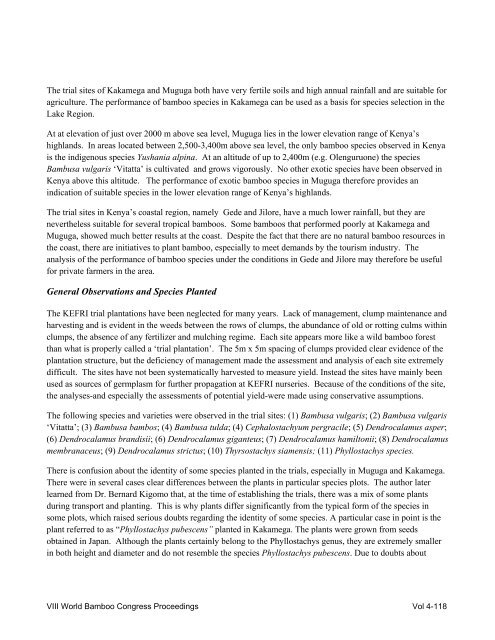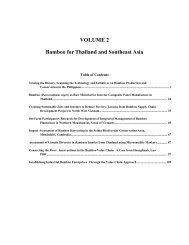WBC-VIII-Vol.4 – Resources – Forestry, Plantations and ... - BambuSC
WBC-VIII-Vol.4 – Resources – Forestry, Plantations and ... - BambuSC
WBC-VIII-Vol.4 – Resources – Forestry, Plantations and ... - BambuSC
You also want an ePaper? Increase the reach of your titles
YUMPU automatically turns print PDFs into web optimized ePapers that Google loves.
The trial sites of Kakamega <strong>and</strong> Muguga both have very fertile soils <strong>and</strong> high annual rainfall <strong>and</strong> are suitable for<br />
agriculture. The performance of bamboo species in Kakamega can be used as a basis for species selection in the<br />
Lake Region.<br />
At at elevation of just over 2000 m above sea level, Muguga lies in the lower elevation range of Kenya’s<br />
highl<strong>and</strong>s. In areas located between 2,500-3,400m above sea level, the only bamboo species observed in Kenya<br />
is the indigenous species Yushania alpina. At an altitude of up to 2,400m (e.g. Olenguruone) the species<br />
Bambusa vulgaris ‘Vitatta’ is cultivated <strong>and</strong> grows vigorously. No other exotic species have been observed in<br />
Kenya above this altitude. The performance of exotic bamboo species in Muguga therefore provides an<br />
indication of suitable species in the lower elevation range of Kenya’s highl<strong>and</strong>s.<br />
The trial sites in Kenya’s coastal region, namely Gede <strong>and</strong> Jilore, have a much lower rainfall, but they are<br />
nevertheless suitable for several tropical bamboos. Some bamboos that performed poorly at Kakamega <strong>and</strong><br />
Muguga, showed much better results at the coast. Despite the fact that there are no natural bamboo resources in<br />
the coast, there are initiatives to plant bamboo, especially to meet dem<strong>and</strong>s by the tourism industry. The<br />
analysis of the performance of bamboo species under the conditions in Gede <strong>and</strong> Jilore may therefore be useful<br />
for private farmers in the area.<br />
General Observations <strong>and</strong> Species Planted<br />
The KEFRI trial plantations have been neglected for many years. Lack of management, clump maintenance <strong>and</strong><br />
harvesting <strong>and</strong> is evident in the weeds between the rows of clumps, the abundance of old or rotting culms within<br />
clumps, the absence of any fertilizer <strong>and</strong> mulching regime. Each site appears more like a wild bamboo forest<br />
than what is properly called a ‘trial plantation’. The 5m x 5m spacing of clumps provided clear evidence of the<br />
plantation structure, but the deficiency of management made the assessment <strong>and</strong> analysis of each site extremely<br />
difficult. The sites have not been systematically harvested to measure yield. Instead the sites have mainly been<br />
used as sources of germplasm for further propagation at KEFRI nurseries. Because of the conditions of the site,<br />
the analyses-<strong>and</strong> especially the assessments of potential yield-were made using conservative assumptions.<br />
The following species <strong>and</strong> varieties were observed in the trial sites: (1) Bambusa vulgaris; (2) Bambusa vulgaris<br />
‘Vitatta’; (3) Bambusa bambos; (4) Bambusa tulda; (4) Cephalostachyum pergracile; (5) Dendrocalamus asper;<br />
(6) Dendrocalamus br<strong>and</strong>isii; (6) Dendrocalamus giganteus; (7) Dendrocalamus hamiltonii; (8) Dendrocalamus<br />
membranaceus; (9) Dendrocalamus strictus; (10) Thyrsostachys siamensis; (11) Phyllostachys species.<br />
There is confusion about the identity of some species planted in the trials, especially in Muguga <strong>and</strong> Kakamega.<br />
There were in several cases clear differences between the plants in particular species plots. The author later<br />
learned from Dr. Bernard Kigomo that, at the time of establishing the trials, there was a mix of some plants<br />
during transport <strong>and</strong> planting. This is why plants differ significantly from the typical form of the species in<br />
some plots, which raised serious doubts regarding the identity of some species. A particular case in point is the<br />
plant referred to as “Phyllostachys pubescens” planted in Kakamega. The plants were grown from seeds<br />
obtained in Japan. Although the plants certainly belong to the Phyllostachys genus, they are extremely smaller<br />
in both height <strong>and</strong> diameter <strong>and</strong> do not resemble the species Phyllostachys pubescens. Due to doubts about<br />
<strong>VIII</strong> World Bamboo Congress Proceedings Vol 4-118




